Plasmonic Refractive Index and Temperature Sensor Based on Graphene and LiNbO3
Abstract
1. Introduction
2. Sensor Design and Materials
3. Methodology
3.1. Modeling and Simulation Presets
3.2. S-Parameters and the Output Response
4. Results and Discussion
4.1. Testing the Device as an RIU Sensor
4.2. Testing the Device as a Temperature Sensor
4.3. Comparative Analysis of the Sensor Design
5. Proposed Fabrication Steps
6. Conclusions
Author Contributions
Funding
Institutional Review Board Statement
Informed Consent Statement
Data Availability Statement
Acknowledgments
Conflicts of Interest
References
- Haleem, A.; Javaid, M.; Singh, R.P.; Suman, R.; Rab, S. Biosensors applications in medical field: A brief review. Sens. Int. 2021, 2, 100100. [Google Scholar] [CrossRef]
- Risso, A.; Rajaram, V.; Kang, S.; Calisgan, S.D.; Pavese, M.M.; Qian, Z.; Rinaldi, M. Zero standby power crop water-stress detector leading to the optimization of water usage and yield. Nat. Sci. Rep. 2022, 12, 12603. [Google Scholar] [CrossRef]
- Avellar, L.; Filho, C.S.; Delgado, G.; Frizera, A.; Rocon, E.; Leal-Junior, A. AI-enabled photonic smart garment for movement analysis. Sci. Rep. 2022, 12, 4067. [Google Scholar] [CrossRef] [PubMed]
- Marie Freebody. Remote Sensing Puts Focus on Climate Change. Available online: https://www.photonics.com/Articles/Remote_Puts_Focus_on_Climate_Change/a65797 (accessed on 5 September 2022).
- Radu Barsan. Photonic Sensors Help Keep Earth Clean, Green. Available online: https://www.photonics.com/Articles/Photonic_Sensors_Help_Keep_Earth_Clean_Green/a50307 (accessed on 5 September 2022).
- Khan, S.; Lorenzelli, L.; Dahiya, R.S. Technologies for Printing Sensors and Electronics Over Large Flexible Substrates: A Review. IEEE Sens. J. 2015, 15, 3164–3185. [Google Scholar] [CrossRef]
- Salem, M.; Elkaseer, A.; El-Maddah, I.A.; Youssef, K.Y.; Scholz, S.G.; Mohamed, H.K. Non-Invasive Data Acquisition and IoT Solution for Human Vital Signs Monitoring: Applications, Limitations and Future Prospects. Sensors 2022, 22, 6625. [Google Scholar] [CrossRef] [PubMed]
- Javaid, M.; Haleem, A.; Singh, R.P.; Rab, S.; Suman, R. Significance of sensors for industry 4.0: Roles, capabilities, and applications. Sci. Sens. Int. 2021, 2, 100110. [Google Scholar] [CrossRef]
- Khan, Y.; Rehman, A.U.; Batool, B.A.; Noor, M.; Butt, M.A.; Kazanskiy, N.L.; Khonina, S.N. Fabrication and Investigation of Spectral Properties of a Dielectric Slab Waveguide Photonic Crystal Based Fano-Filter. Crystals 2022, 12, 226. [Google Scholar] [CrossRef]
- Ahmed, U.; Khan, Y.; Ehsan, M.K.; Amirzada, M.R.; Ullah, N.; Khatri, A.R.; Rehman, A.U.; Butt, M.A. Investigation of Spectral Properties of DBR-Based Photonic Crystal Structure for Optical Filter Application. Crystals 2022, 12, 409. [Google Scholar] [CrossRef]
- Miyazaki, C.M.; Shimizu, F.M.; Ferreira, M. Surface Plasmon Resonance (SPR) for Sensors and Biosensors, Nanocharacterization Techniques. In Nanocharacterization Techniques; William Andrew Publishing: Norwich, NY, USA, 2017. [Google Scholar]
- Khonina, S.N.; Butt, M.A.; Kazanskiy, N.L. Numerical investigation of metasurface narrowband perfect absorber and plasmonic sensor for near infrared wavelength range. J. Opt. 2021, 23, 065102. [Google Scholar] [CrossRef]
- Gandhi, M.A.; Chu, S.; Senthilnathan, K.; Babu, P.R.; Nakkeeran, K.; Li, Q. Recent advances in plasmonic sensor-based fiber optic probes for biological applications. Appl. Sci. 2019, 9, 949. [Google Scholar] [CrossRef]
- Chong, X.; Kim, K.J.; Zhang, Y.; Li, E.; Ohodnicki, P.R.; Chang, C.H.; Wang, A.X. Plasmonic nanopatch array with integrated metal-organic framework for enhanced infrared absorption gas sensing. Nanotechnology 2017, 28, 26LT01. [Google Scholar] [CrossRef]
- Lahlalia, A.; Le Neel, O.; Shankar, R.; Selberherr, S.; Filipovic, L. Enhanced Sensing Performance of Integrated Gas Sensor Devices. Multidiscip. Digit. Publ. Inst. Proc. 2018, 2, 1508. [Google Scholar] [CrossRef]
- Janeiro, R.; Flores, R.; Viegas, J. Silicon photonics waveguide array sensor for selective detection of VOCs at room temperature. Sci. Rep. 2019, 9, 1–13. [Google Scholar] [CrossRef] [PubMed]
- Parmar, J.; Patel, S.K. Tunable and highly sensitive graphene-based biosensor with circle/split ring resonator metasurface for sensing hemoglobin/urine biomolecules. Phys. B Condens. Matter. 2021, 624, 413399. [Google Scholar] [CrossRef]
- Zhu, Z.; Liu, L.; Liu, Z.; Zhang, Y.; Zhang, Y. Surface-plasmon-resonance-based optical-fiber temperature sensor with high sensitivity and high figure of merit. Opt. Lett. 2017, 42, 2948–2951. [Google Scholar] [CrossRef]
- Li, L.; Cui, W.; He, Z.; Xue, W.; He, H. Plasmonic Sensor Based on Silver Nanoparticles for the Detection of Glucose. Plasmonics 2022, 17, 1231–1234. [Google Scholar] [CrossRef]
- Nejat, M.; Nozhat, N. Multi-band MIM refractive index biosensor based on Ag-air grating with equivalent circuit and T-matrix methods in near-infrared region. Nat. Sci. Rep. 2020, 10, 6357. [Google Scholar] [CrossRef] [PubMed]
- Pitruzzello, G.; Krauss, T.F. Photonic crystal resonances for sensing and imaging. J. Opt. 2018, 20, 073004. [Google Scholar] [CrossRef]
- Jain, S.; Choudhary, K.; Kumar, S. Photonic crystal fiber-based SPR sensor for broad range of refractive index sensing applications. Opt. Fiber Technol. 2022, 73, 103030. [Google Scholar] [CrossRef]
- Liang, Y.; Zhao, M.; Wu, Z.; Morthier, G. Bimodal Waveguide Interferometer RI Sensor Fabricated on Low-Cost Polymer Platform. IEEE Photon. J. 2019, 11, 1–8. [Google Scholar] [CrossRef]
- Al Mahfuz, M.; Hossain, A.; Haque, E.; Hai, N.H.; Namihira, Y.; Ahmed, F. Dual-Core Photonic Crystal Fiber-Based Plasmonic RI Sensor in the Visible to Near-IR Operating Band. IEEE Sens. J. 2020, 20, 7692–7700. [Google Scholar] [CrossRef]
- Zhu, Y.; Zhang, H.; Li, D.; Zhang, Z.; Yi, J.; Wang, W. Magnetic plasmons in a simple metallic nanogroove array for refractive index sensing. Opt. Express 2018, 26, 9148–9154. [Google Scholar] [CrossRef] [PubMed]
- Mahmoud, M.A.; El-Sayed, M.A. Different Plasmon Sensing Behavior of Silver and Gold Nanorods. J. Phys. Chem. Lett. 2013, 4, 1541–1545. [Google Scholar] [CrossRef] [PubMed]
- Chen, K.; Zhu, Y.; Liu, Z.; Xue, D. State of the Art in Crystallization of LiNbO3 and Their Applications. Molecules 2021, 26, 7044. [Google Scholar] [CrossRef] [PubMed]
- Liang, H.; Luo, R.; He, Y.; Jiang, H.; Lin, Q. High-quality lithium niobate photonic crystal nanocavities. Optica 2017, 4, 1251–1258. [Google Scholar] [CrossRef]
- LiNbO3 Substrate for Research & Development. Available online: https://www.universitywafer.com/Wafers_Services/LiNbO3/linbo3.html (accessed on 6 September 2022).
- Bernal, M.P.; Roussey, M.; Baida, F.; Benchabane, S.; Khelif, A.; Laude, V. Photonic and Phononic Band Gap Properties of Lithium Niobate. In Ferroelectric Crystals for Photonic Applications; Springer: Berlin/Heidelberg, Germany, 2009; Volume 91, pp. 307–336. [Google Scholar] [CrossRef]
- Silicon Dioxide SiO2. Available online: https://Materion.com/resource-center/newsletter/newsletter-archives/coating-material-news-2000-to-2010/silicon-dioxide-sio2-for-optical-coating (accessed on 6 September 2022).
- Parmar, J.; Patel, S.K.; Katkar, V. Graphene-based metasurface solar absorber design with absorption prediction using machine learning. Sci. Rep. 2022, 12, 2609. [Google Scholar] [CrossRef]
- Ikegami, K.; Harako, S.; Ooka, K.; Zhao, X. Fabrication Method of Graphite Thin Films from Organic Solutions. Trans. Mater. Res. Soc. Jpn. 2011, 36, 173–175. [Google Scholar] [CrossRef][Green Version]
- Optical properties of Plasmonic Material. Chapter 1, pp. 1–39, SPIE Digital Library. Available online: spie.org (accessed on 2 September 2022).
- McGrath, M.J.; Scanaill, C.N. Sensing and Sensor Fundamentals. In Sensor Technologies; Apress: Berkeley, CA, USA, 2013; pp. 15–50. [Google Scholar] [CrossRef]
- Lötters, J.C.; Olthuis, W.; Veltink, P.; Bergveld, P. The mechanical properties of the rubber elastic polymer polydimethylsiloxane for sensor applications. J. Micromech. Microeng. 1997, 7, 145–147. [Google Scholar] [CrossRef]
- Butt, M.A.; Khonina, S.N.; Kazanskiy, N.L.; Piramidowicz, R. Hybrid Metasurface perfect absorbers for temperature and biosensing applications. Opt. Mater. 2022, 123, 111906. [Google Scholar] [CrossRef]
- Wei, N.; Xu, P.; Yao, Y.; Li, J.; Liu, E.; Luo, J. Bragg grating sensor for refractive index based on a D-shaped circular photonic crystal fiber. J. Opt. Soc. Am. A 2022, 39, 800–805. [Google Scholar] [CrossRef]
- Choi, B.B.; Kim, B.; Chen, Y.; Yoo, S.J.; Cho, Y.; Jiang, P. Elevated surface plasmon resonance sensing sensitivity of Au-covered silixa sphere monolayer prepared by langmuir- Blodgett coating. J. Ind. Eng. Chem. 2021, 99, 179–186. [Google Scholar] [CrossRef]
- Wang, S.; Sun, X.; Ding, M.; Peng, G.; Qi, Y.; Wang, Y.; Ren, J. The investigation of an LSPR refractive index sensor based on period gold nanoring array. J. Phys. D Appl. Phys. 2018, 51, 045101. [Google Scholar] [CrossRef]
- Zhang, M.; Fang, J.; Zhang, F.; Chen, J.; Yu, H. Ultra-narrow band perfect absorber basen on Fano resonance in MIM metamaterials. Opt. Commun. 2017, 405, 216–221. [Google Scholar] [CrossRef]
- Chen, J.; Zhang, Q.; Peng, C.; Tang, C.; Shen, X.; Deng, L.; Park, G.-S. Optical Cavity-Enhanced Localized Surface Plasmon Resonance for High-Quality Sensing. IEEE Photon-Technol. Lett. 2018, 30, 728–731. [Google Scholar] [CrossRef]
- Fabitha, K.; Rao, M.S.R. Biocompatible miniature temperature sensor based on whispering gallery modes of Sm3+ activated ZnO optical micro-resonators. Appl. Phys. Lett. 2021, 118, 163104. [Google Scholar] [CrossRef]
- Batumalay, M.; Johari, A.; Khudus, M.I.M.A.; Bin Jali, M.H.; Al Noman, A.; Harun, S.W. Microbottle resonator for temperature sensing. J. Physics Conf. Ser. 2019, 1371, 012006. [Google Scholar] [CrossRef]
- Micro and Nano Processing Technologies. In Pulsed Laser Deposition of Thin Films of Functional Materials; Chalmers University: Gothenburg, Sweden, 2022; Graduate School at MC2.
- Kumar, S.; Peltekis, N.; Lee, K.; Kim, H.-Y.; Duesberg, G.S. Reliable processing of graphene using metal etchmasks. Nanoscale Res. Lett. 2011, 6, 390. [Google Scholar] [CrossRef] [PubMed]
- Jiang, X.; Hu, S.; Li, Z.; Lv, J.; Si, G. Fabrication and Characterization of plasmonic nanorods with high aspect ratios. Opt. Mater. 2016, 58, 323–326. [Google Scholar] [CrossRef]
- Verschuuren, M.A.; De Dood, M.J.A.; Stolwijk, D.; Polman, A. Optical properties of high quality nanohole arrays in gold made using soft-nanoimprint lithography. MRS Commun. 2015, 5, 547–553. [Google Scholar] [CrossRef]
- Vinnacombe-Willson, G.A.; Conti, Y.; Jonas, S.J.; Weiss, P.S.; Mihi, A.; Scarabelli, L. Surface lattice plasmone resonances by direct in situ substrate growth of gold nanoparticles in ordered arrays. Adv. Mater. 2022, 37, 2205330. [Google Scholar] [CrossRef]

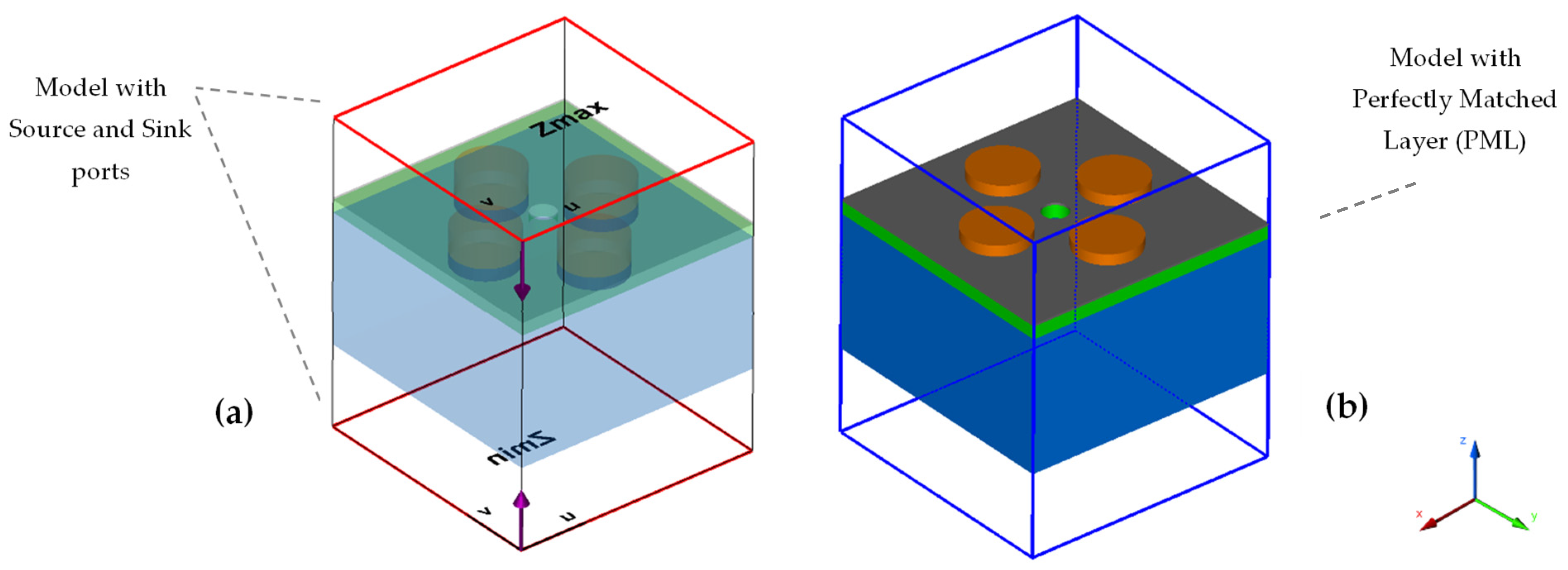
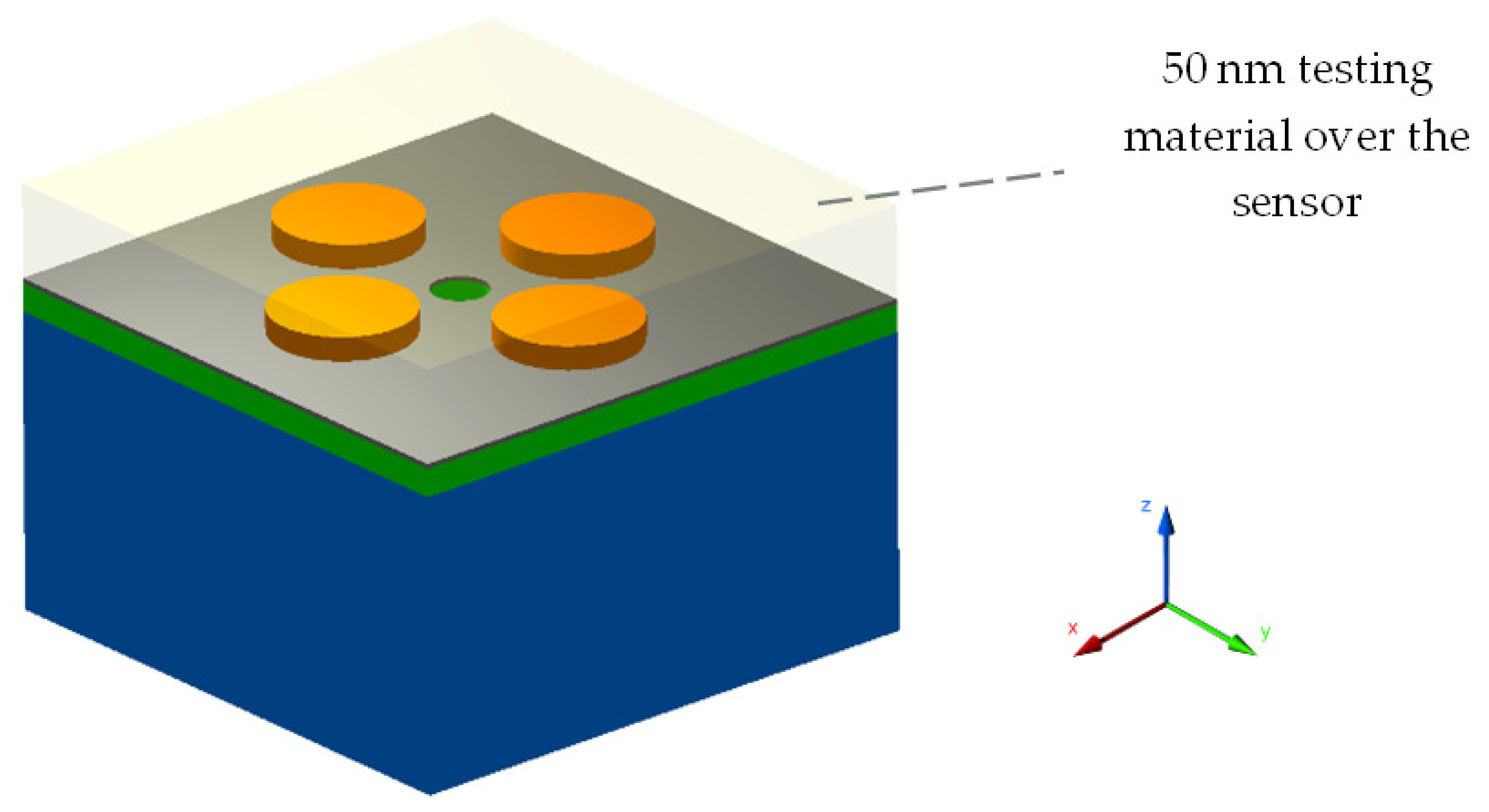
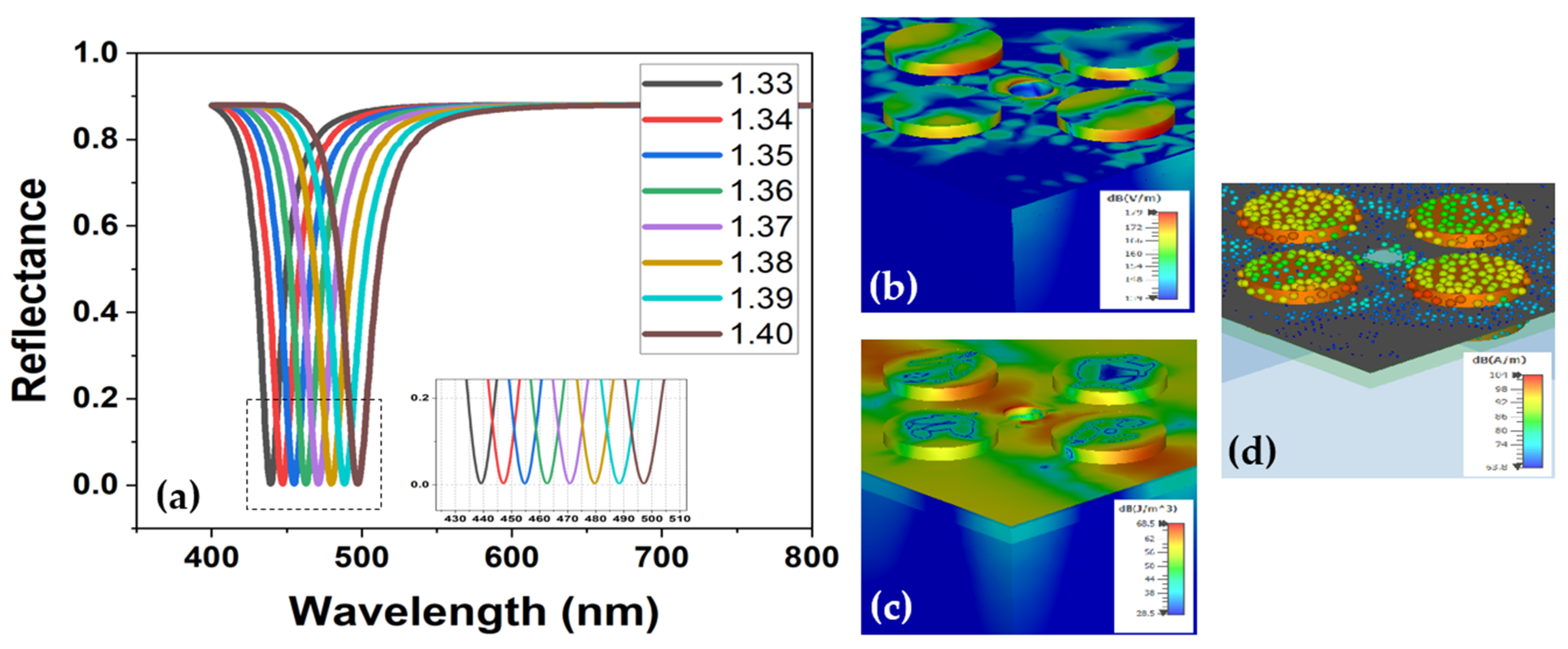
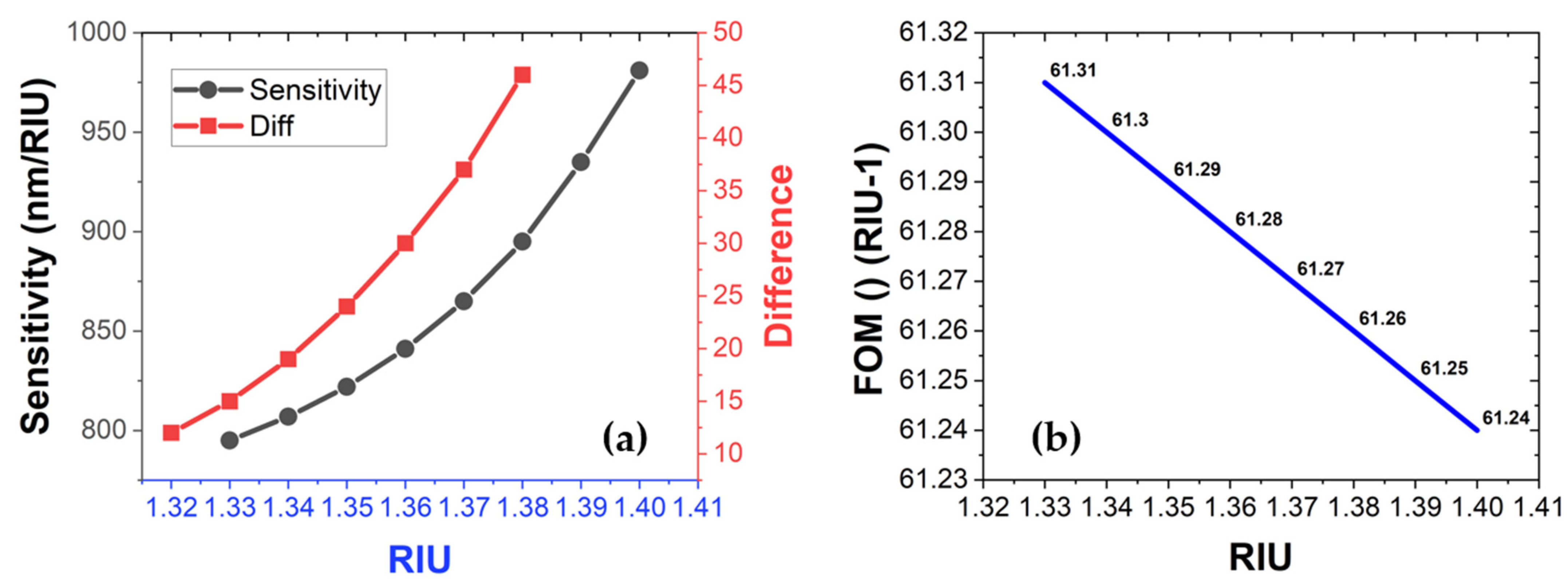
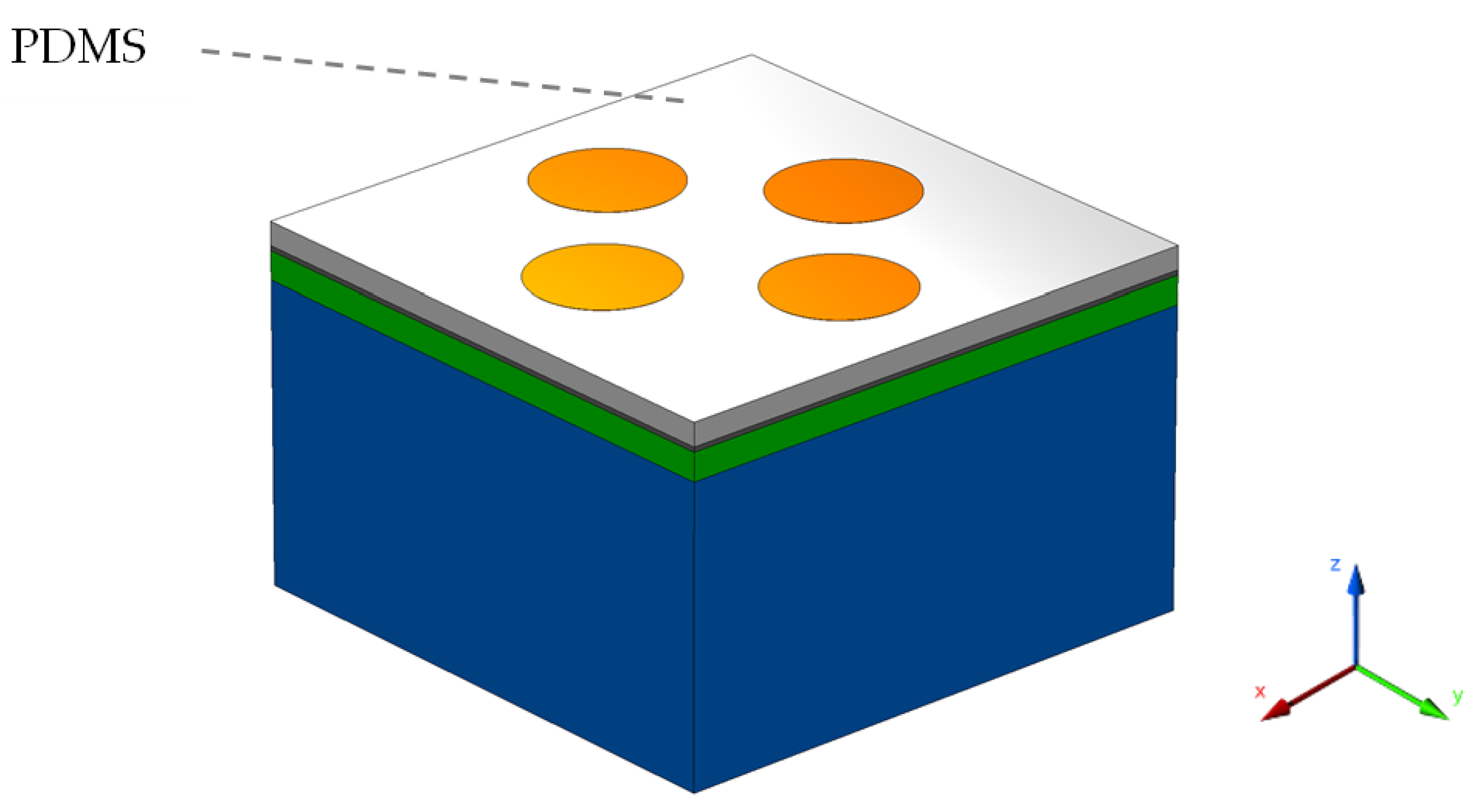
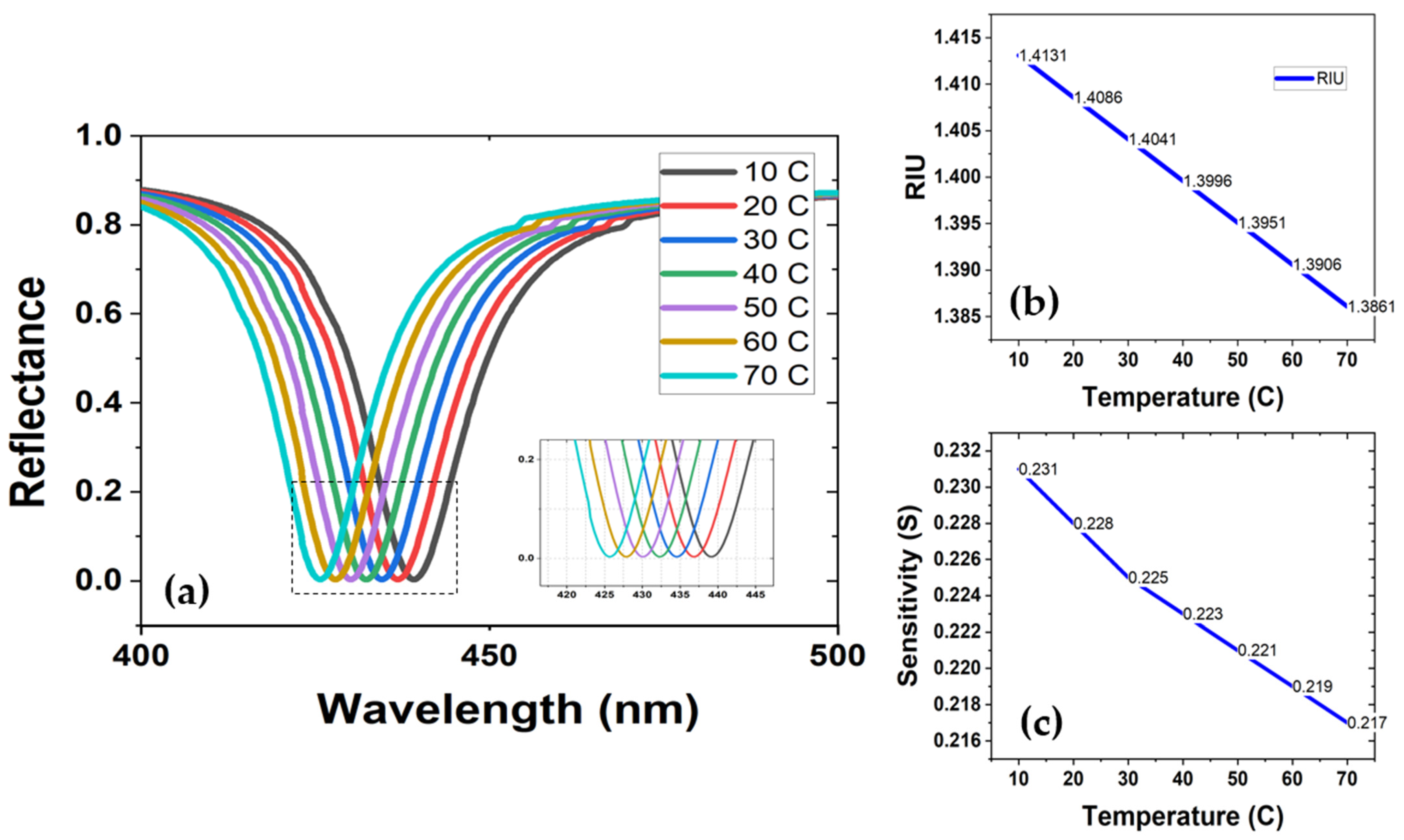

| Layers (Bottom to Top) | Material | Measurement |
|---|---|---|
| Layer 1 | LiNbO3 | 200 nm |
| Layer 2 | SiO2 | 20 nm |
| Layer 3 | Graphene | 0.34 nm (0.00034 µm) |
| Layer 4 | Gold Nano-rod | 50 nm radius × 60 nm L |
| PhC-hole | Air | 20 nm radius |
| Layer 5 | Testing Material or PDMS | 50 nm/16.6 nm |
| Application | Temperature Range (°C) | Wavelength (nm) | Sensitivity (nm/°C) |
|---|---|---|---|
| Temperature sensing | 10 | 439.27 | −0.231 |
| 20 | 436.96 | −0.228 | |
| 30 | 434.68 | −0.225 | |
| 40 | 432.43 | −0.223 | |
| 50 | 430.20 | −0.221 | |
| 60 | 427.99 | −0.219 | |
| 70 | 425.80 | −0.217 |
| Sensor Design | Sensitivity (nm/RIU) | FOM (RIU−1) | Research Work |
|---|---|---|---|
| D-shaped DBR fiber + Au + PDMS | 487 | - | [38] |
| Silica spheres + Au | 968 | 2.20 | [39] |
| Periodic Au rings array | 557 | 6.1 | [40] |
| Ag + Si + Ag dual elliptical array | 503 | 63 | [41] |
| Silica + Au slab + Si + Fabry–Perot nanocavities + Au slab | 600 | 28 | [42] |
| LiNb3 + graphene | 981 | 61.31 | This Work |
Publisher’s Note: MDPI stays neutral with regard to jurisdictional claims in published maps and institutional affiliations. |
© 2022 by the authors. Licensee MDPI, Basel, Switzerland. This article is an open access article distributed under the terms and conditions of the Creative Commons Attribution (CC BY) license (https://creativecommons.org/licenses/by/4.0/).
Share and Cite
Irfan, M.; Khan, Y.; Rehman, A.U.; Butt, M.A.; Khonina, S.N.; Kazanskiy, N.L. Plasmonic Refractive Index and Temperature Sensor Based on Graphene and LiNbO3. Sensors 2022, 22, 7790. https://doi.org/10.3390/s22207790
Irfan M, Khan Y, Rehman AU, Butt MA, Khonina SN, Kazanskiy NL. Plasmonic Refractive Index and Temperature Sensor Based on Graphene and LiNbO3. Sensors. 2022; 22(20):7790. https://doi.org/10.3390/s22207790
Chicago/Turabian StyleIrfan, Muhammad, Yousuf Khan, Atiq Ur Rehman, Muhammad A. Butt, Svetlana N. Khonina, and Nikolay L. Kazanskiy. 2022. "Plasmonic Refractive Index and Temperature Sensor Based on Graphene and LiNbO3" Sensors 22, no. 20: 7790. https://doi.org/10.3390/s22207790
APA StyleIrfan, M., Khan, Y., Rehman, A. U., Butt, M. A., Khonina, S. N., & Kazanskiy, N. L. (2022). Plasmonic Refractive Index and Temperature Sensor Based on Graphene and LiNbO3. Sensors, 22(20), 7790. https://doi.org/10.3390/s22207790











